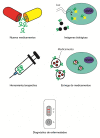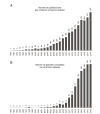Aptamers as a novel diagnostic and therapeutic tool and their potential use in parasitology
- PMID: 32463617
- PMCID: PMC7449109
- DOI: 10.7705/biomedica.4765
Aptamers as a novel diagnostic and therapeutic tool and their potential use in parasitology
Abstract
Aptamers are single-stranded DNA or RNA sequences that adopt unique three-dimensional structures that allow them to recognize a specific target with high affinity. They can potentially be used for the diagnosis of diseases, as new therapeutic agents, for the detection of food risks, as biosensors, for the detection of toxins, and as drug carriers and nanoparticle markers, among other applications. To date, an aptamer called pegaptanib is the only aptamer approved by the Food and Drug Administration (FDA) for commercial use. Other aptamers are in different clinical stages of development for the treatment of different diseases. In parasitology, investigations carried out with parasites such as Leishmania spp. allowed the acquisition of aptamers that recognize the polyA-binding protein LiPABP and may have potential applications in research and diagnosis and even as therapeutic agents. Regarding malaria, aptamers have been obtained that allow the identification of infected erythrocytes or inhibit the formation of rosettes, along with those that provide promising alternatives for diagnosis by specifically detecting the protein lactate dehydrogenase (PfLDH). In Cryptosporidium parvum allow the detection of oocysts in contaminated food or water. In Entamoeba histolytica, two aptamers called C4 and C5, which inhibit the proliferation of trophozoites in vitro and have potential use as therapeutic agents, have been isolated. Aptamers obtained against Trypanosoma cruzi inhibit the invasion of LLC-MK2 (from monkey kidney) cells by 50-70%, and in T. brucei, aptamers with the potential to transport toxic molecules to the parasitic lysosome were identified as a novel therapeutic strategy.
Los aptámeros son secuencias de ADN o ARN de cadena sencilla que adoptan la forma de estructuras tridimensionales únicas, lo cual les permite reconocer un blanco específico con gran afinidad. Sus usos potenciales abarcan, entre otros, el diagnóstico de enfermedades, el desarrollo de nuevos agentes terapéuticos, la detección de riesgos alimentarios, la producción de biosensores, la detección de toxinas, el transporte de fármacos en el organismo y la señalización de nanopartículas. El pegaptanib es el único aptámero aprobado para uso comercial por la Food and Drug Administration (FDA). En parasitología, se destacan los estudios que se vienen realizando en Leishmania spp., con la obtención de aptámeros que reconocen la proteína de unión a poliA (LiPABP) y que pueden tener potencial utilidad en la investigación, el diagnóstico y el tratamiento de la leishmaniasis. En cuanto a la malaria, se han obtenido aptámeros que permiten identificar eritrocitos infectados e inhiben la formación de rosetas, y otros que prometen ser alternativas para el diagnóstico al detectar de forma específica la proteína lactato deshidrogenasa (PfLDH). Para Cryptosporidium parvuum se han seleccionado aptámeros que detectan ooquistes a partir de alimentos o aguas contaminadas. Para Entamoeba histolytica se han aislado dos aptámeros llamados C4 y C5, que inhiben la proliferación in vitro de los trofozoítos y tienen potencial terapéutico. Los aptámeros contra Trypanosoma cruzi inhiben la invasión de células LLC-MK2 (de riñón de mono) en un 50 a 70 % y aquellos contra T. brucei transportan moléculas tóxicas al lisosoma parasitario como una novedosa estrategia terapéutica.
Keywords: aptamers; nucleotide; peptide; SELEX aptamer technique; antibodies; monoclonal; parasitology; malaria; leishmaniasis; tripanosomiasis; amebiasis.
Figures




Similar articles
-
Advances on Aptamers against Protozoan Parasites.Genes (Basel). 2018 Nov 28;9(12):584. doi: 10.3390/genes9120584. Genes (Basel). 2018. PMID: 30487456 Free PMC article. Review.
-
Aptamers as a promising approach for the control of parasitic diseases.Braz J Infect Dis. 2016 Nov-Dec;20(6):610-618. doi: 10.1016/j.bjid.2016.08.011. Epub 2016 Oct 15. Braz J Infect Dis. 2016. PMID: 27755981 Free PMC article. Review.
-
Detection of Cryptosporidium parvum Oocysts on Fresh Produce Using DNA Aptamers.PLoS One. 2015 Sep 3;10(9):e0137455. doi: 10.1371/journal.pone.0137455. eCollection 2015. PLoS One. 2015. PMID: 26334529 Free PMC article.
-
Aptamers: Potential Diagnostic and Therapeutic Agents for Blood Diseases.Molecules. 2022 Jan 7;27(2):383. doi: 10.3390/molecules27020383. Molecules. 2022. PMID: 35056696 Free PMC article. Review.
-
Molecular and Functional Characterization of ssDNA Aptamers that Specifically Bind Leishmania infantum PABP.PLoS One. 2015 Oct 12;10(10):e0140048. doi: 10.1371/journal.pone.0140048. eCollection 2015. PLoS One. 2015. PMID: 26457419 Free PMC article.
Cited by
-
Development and characterization of high-affinity aptamers for HIV protease detection.Heliyon. 2024 Sep 20;10(22):e38234. doi: 10.1016/j.heliyon.2024.e38234. eCollection 2024 Nov 30. Heliyon. 2024. PMID: 39624307 Free PMC article.
-
Nanodiagnostics in leishmaniasis: A new frontiers for early elimination.Wiley Interdiscip Rev Nanomed Nanobiotechnol. 2021 Mar;13(2):e1675. doi: 10.1002/wnan.1675. Epub 2020 Nov 3. Wiley Interdiscip Rev Nanomed Nanobiotechnol. 2021. PMID: 33142369 Free PMC article. Review.
-
Systematic Evolution of Ligands by Exponential Enrichment Technologies and Aptamer-Based Applications: Recent Progress and Challenges in Precision Medicine of Infectious Diseases.Front Bioeng Biotechnol. 2021 Aug 10;9:704077. doi: 10.3389/fbioe.2021.704077. eCollection 2021. Front Bioeng Biotechnol. 2021. PMID: 34447741 Free PMC article. Review.
-
Solid Lipid Nanoparticles, an Alternative for the Treatment of Triple-Negative Breast Cancer.Int J Mol Sci. 2024 Oct 5;25(19):10712. doi: 10.3390/ijms251910712. Int J Mol Sci. 2024. PMID: 39409041 Free PMC article. Review.
-
Diagnosis and control of cryptosporidiosis in farm animals.J Parasit Dis. 2022 Dec;46(4):1133-1146. doi: 10.1007/s12639-022-01513-2. Epub 2022 Jul 4. J Parasit Dis. 2022. PMID: 36457776 Free PMC article. Review.
References
Publication types
MeSH terms
Substances
LinkOut - more resources
Full Text Sources
Medical
Miscellaneous

